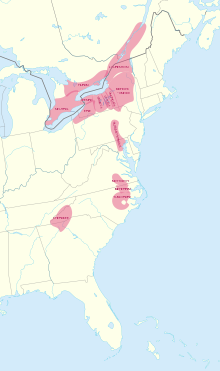Iroquoian languages
The Iroquoian languages are a language family of indigenous peoples of North America. They are known for their general lack of labial consonants. The Iroquoian languages are polysynthetic and head-marking.[1]
As of 2020, all surviving Iroquoian languages are severely or critically endangered, with only a few elderly speakers remaining. The two languages with the most speakers, Mohawk in New York and Cherokee, are spoken by less than 10% of the populations of their tribes.[2][3]
Evidence is emerging that what has been called the Laurentian language appears to be more than one dialect or language.[4] Ethnographic and linguistic field work with the Wyandot tribal elders (Barbeau 1960) yielded enough documentation for scholars to characterize and classify the Huron and Petun languages.
The languages of the tribes that constituted the tiny Wenrohronon,[a] the powerful Conestoga Confederacy and the confederations of the Neutral Nation and the Erie Nation are very poorly documented in print. The Neutral were called Atiwandaronk, meaning 'they who understand the language' by the Huron (Wyandot people). They are historically grouped together, and geographically the Wenro's range on the eastern end of Lake Erie placed them between the larger confederations. To the east of the Wenro, beyond the Genesee Gorge, were the lands of the Haudenosaunee Confederacy and southeast, beyond the headwaters of the Allegheny River, lay the Conestoga (Susquehannocks).[5] The Conestoga Confederacy and Erie were militarily powerful and respected by neighboring tribes.[5] By 1660 all of these peoples but the Conestoga Confederacy and the Haudenosaunee Confederacy were defeated and scattered, migrating to form new tribes or adopted into others—the practice of adopting valiant enemies into the tribe was a common cultural tradition of the Iroquoian peoples.[5]
The group known as the Meherrin were neighbors to the Tuscarora and the Nottoway (Binford 1967) in the American South and may have spoken an Iroquoian language. There is not enough data to determine this with certainty.
Attempts to link the Iroquoian, Siouan, and Caddoan languages in a Macro-Siouan family are suggestive but remain unproven (Mithun 1999:305).
